International Journal of Computer Network and Information Security @ijcnis
Статьи журнала - International Journal of Computer Network and Information Security
Все статьи: 1166
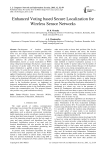
Enhanced Voting based Secure Localization for Wireless Sensor Networks
Статья научная
Development of location estimation algorithms with improvement in location precision with lower cost, less energy consumption and less hardware support has become more important for many applications in Wireless Sensor Networks (WSNs). This paper addresses the problem of secure location determination, known as secure localization in WSNs using voting based technique which gives a search region in presence of anchor nodes. From the obtained search region trilateration is applied to know the position of sensor nodes. To avoid the involvement of sensor nodes in further location estimation process, bilateration is applied. Experimental analysis shows that the maximum number of nodes can be localized and accurate location of a node can be determined efficiently with low estimation error. To avoid the attacks and involvement of malicious nodes in the localization process, we implement an improved authentication and security algorithm. Using few location reference points in the localization process reduces the communication cost. The proposed scheme also provides very good localization accuracy.
Бесплатно

Enhanced Wireless Sensor Network Lifetime using Modified SFLA with Improved Fitness Function
Статья научная
In the pursuit of enhancing Wireless Sensor Networks (WSNs), this study introduces a novel amalgamation of the Enhanced Shuffled Frog Leaping Algorithm (ESFLA) with a multi-solution evolution paradigm. By intricately examining diverse algorithmic facets, including partitioning strategies, fitness functions, and convergence mechanisms, the research endeavors to elevate the efficiency, robustness, and longevity of WSNs. Rigorous experimentation across 15 input datasets, meticulously categorized based on network density, unveils profound insights into the algorithm's performance. Significantly, the proposed ESFLA-MSU achieves exceptional outcomes, eclipsing traditional methods. A pioneering fitness function optimally redistributes workloads, culminating in extended network lifespans, a striking reduction in energy consumption by up to 28.5%, and remarkable load balancing improvements of up to 35.7%. Comparative analyses of partitioning strategies underscore ESFLA's adaptability, while multi-solution evolution integration accelerates convergence, with an expedited rate of up to 46.3%.
Бесплатно
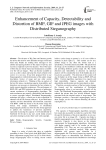
Статья научная
The advance of Big Data and Internet growth has driven the need for more abundant storage to hold and share data. People are sending more messages to one another and paying attention to the aspects of privacy and security as opposed to previous decades. One of the types of files that are widely shared and instantaneous available over the web are images. They can become available as soon as a shot is taken and keep this closely related to the owner; it is not easy. It has been proposed here to use Steganography to embed information of the author, image description, license of usage and any other secrete information related to it. Thinking of this, an analysis of the best file types, considering capacity, detectability, and distortion was necessary to determine the best solution to tackle current algorithm weaknesses. The performance of BMP, GIF, and JPEG initialises the process of addressing current weaknesses of Steganographic algorithms. The main weaknesses are capacity, detectability and distortion to secure copyright images. Distributed Steganography technique also plays a crucial part in this experiment. It enhances all the file formats analysed. It provided better capacity and less detectability and distortion, especially with BMP. BMP has found to be the better image file format. The unique combination of Distributed Steganography and the use of the best file format approach to address the weaknesses of previous algorithms, especially increasing the capacity. It will undoubtedly be beneficial for the day to day user of social media image creators and artists looking to protect their work with copyright.
Бесплатно
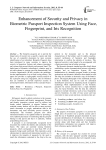
Статья научная
The biometric passports are to prevent the illegal entry of traveler into a specific country and limit the use of counterfeit documents by more accurate identification of an individual. Biometric Passports have been introduced in many countries to improve the security in Inspection Systems and enhance procedures and systems that prevent identity and passport fraud. The deployment of biometric technologies, countries need to test and evaluate its systems since the International Civil Aviation Organization (ICAO) provides the guidelines, but the implementation is up to each issuing country. The paper also provides a cryptographic security analysis of the e-passport using face fingerprint, and iris biometric that are intended to provide improved security in protecting biometric information of the e-passport bearer.
Бесплатно
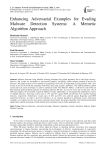
Enhancing Adversarial Examples for Evading Malware Detection Systems: A Memetic Algorithm Approach
Статья научная
Malware detection using Machine Learning techniques has gained popularity due to their high accuracy. However, ML models are susceptible to Adversarial Examples, specifically crafted samples intended to deceive the detectors. This paper presents a novel method for generating evasive AEs by augmenting existing malware with a new section at the end of the PE file, populated with binary data using memetic algorithms. Our method hybridizes global search and local search techniques to achieve optimized results. The Malconv Model, a well-known state-of-the-art deep learning model designed explicitly for detecting malicious PE files, was used to assess the evasion rates. Out of 100 tested samples, 98 successfully evaded the MalConv model. Additionally, we investigated the simultaneous evasion of multiple detectors, observing evasion rates of 35% and 44% against KNN and Decision Tree machine learning detectors, respectively. Furthermore, evasion rates of 26% and 10% were achieved against Kaspersky and ESET commercial detectors. In order to prove the efficiency of our memetic algorithm in generating evasive adversarial examples, we compared it to the most used evolutionary-based attack: the genetic algorithm. Our method demonstrated significantly superior performance while utilizing fewer generations and a smaller population size.
Бесплатно
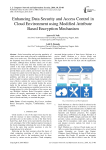
Статья научная
Social networking and growing popularity of cloud services have made everyone to communicate each other in an easiest way. File sharing and distribution are the frequently used services provided by cloud service providers, although these facilities reduce cost of data sharing but at the same time data security and access control is the major problem. Many renowned service providers have faced the challenges to secure data and provide better access control, and we know once the data is leaked we cannot recover the data loss. Thus in order to ensure better security we need for focus on the two major problems, and those are access control and encryption policy. Cipher text policy attribute based encryption is the most effective solution for access control in real time scenarios where owner can actually decide the access rights for the end-user, but it comes with key escrow problem. We are proposing our modified escrow-free key issuing protocol to solve the problem of key escrow and our Modified Attribute Based Encryption scheme to achieve all security requirements to get a robust and secure system. Further we evaluate our model on the basis of results and lastly we conclude the paper.
Бесплатно

Enhancing Hash Function Selection Techniques Based on Message Contents
Статья научная
In Hash based Security systems two major factors that are mostly relied upon are Strong Hash function and the selection procedure of the hash function from a given pool. This paper aims at exploiting maximum available resources a message possesses, intrinsically, that can accommodate greater number of hash functions references. It provides a simple, low cost- easy to implement technique that will be able to make systems available with random hash functions’ selection ability. With the given technique the security level will be enhanced along with greater availability of hash functions. The truly variable nature of contents of messages can be exploited in order to secure messages beyond measure. In case of a single communication stint, if one hash function is compromised the next hash function for next block will be selected truly randomly and cannot be predicted. A summary of already in use techniques is also discussed in order to prove the proposition distinct and practicable. In proposed technique it is proven that it has ability to accommodate greater number of hash functions. Further, the hash function selection methodology has been provisioned with a technique to be message-dependent; the security cannot be compromised owing to truly randomness of the selection procedure.
Бесплатно
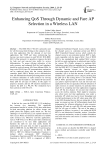
Enhancing QoS Through Dynamic and Fare AP Selection in a Wireless LAN
Статья научная
The IEEE 802.11 WLAN is primarily used for web browsing which belongs to the category of non-real time application. But the demand of real time applications like VOIP and video conferencing has become very much common to such WLAN. With IEEE 802.11e Mac protocol it is possible to improve the QoS for both real and non-real time traffic by service differentiation. To ensure efficient utilization of the radio resources and enhanced QoS the load imbalance should be resolved among APs from different BSSs. In large scale WLAN inter AP communication mechanism can be employed along side the current admission controller under EDCA. Beside service differentiation inter AP differentiation based QoS management can lead to efficient utilization of radio resources by moving STAs from heavily laded to a less loaded AP and ensure better QoS for all types of traffics. In this paper we propose a dynamic and fair AP selection mechanism to improve the QoS in a WLAN. The simulations have been carried out with NSv2.34.
Бесплатно
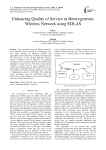
Enhancing Quality of Service in Heterogeneous Wireless Network using EDLAS
Статья научная
The transmission through different interfaces of the different wireless network is a challenging issue. This paper presents an enhanced dynamic link aggregation scheme (EDLAS), an enhanced technique for the transmission of data through different interfaces present in different wireless networks. The proposed technique uses the existing sequential and parallel DLAS technique by using the fuzzy. The fuzzy system decides whether to transfer data by using sequential or the parallel DLAS depending upon the number of the chunks, user mobility, the number of users, chunk size. The work is implemented using the MATLAB. The simulation results generated using the MATLAB shows the effectiveness of the technique with increased throughput with same residual battery power.
Бесплатно
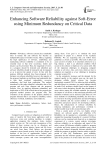
Enhancing Software Reliability against Soft-Error using Minimum Redundancy on Critical Data
Статья научная
Nowadays, software systems play remarkable roles in human life and software has become an indispensable aspect of modern society. Hence, regarding the high significance of software, establishing and maintaining software reliability is considered to be an essential issue so that error occurrence, failure and disaster can be prevented. Thus, the magnitude of errors in a program should be detected and identified and software reliability should be measured and investigated so as to prevent the spread of error. In line with this purpose, different methods have been proposed in the literature on software reliability; however, the majority of the proposed methods are inefficient and undesirable due to their high overhead, vulnerability, excessive redundancy and high data replication. The method introduced in this paper identifies vulnerable data of the program and uses class diagram and the proposed formula. Also, by applying minimum redundancy and duplication on 70% of the critical data of the program, the proposed method protects the program data. The evaluation of the operation of the propose method on program indicated that it can improve reliability, reduce efficiency overhead, redundancy and complexity.
Бесплатно
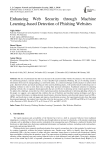
Enhancing Web Security through Machine Learning-based Detection of Phishing Websites
Статья научная
The rise of cyberattacks has led to an increase in the creation of fake websites by attackers, who use these sites for advertising products, transmit malware, or steal valuable login credentials. Phishing, the act of soliciting sensitive information from users by masquerading as a trustworthy entity, is a common technique used by attackers to achieve their goals. Spoofed websites and email spoofing are often used in phishing attacks, with spoofed emails redirecting users to phishing websites in order to trick them into revealing their personal information. Traditional solutions for detecting phishing websites rely on signature-based approaches that are not effective in detecting newly created spoofed websites. To address this challenge, researchers have been exploring machine-learning methods for detecting phishing websites. In this paper, we suggest a new approach that combines the use of blacklists and machine learning techniques such that a variety of powerful features, including domain-based features, abnormal features, and abnormal features based on URLs, HTML, and JavaScript, to rank web pages and improve classification accuracy. Our experimental results show that using the proposed approach, the random forest classifier offers the best accuracy of 93%, with FPR and FNR as 0.12 and 0.02, with a Precision of 90%, Recall of 97% an F1 Score of 93%, and MCC of 0.85.
Бесплатно
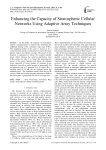
Enhancing the Capacity of Stratospheric Cellular Networks Using Adaptive Array Techniques
Статья научная
In this paper, the capacity of stratospheric cellular communications is improved by optimizing the amplitude feeding of the concentric rings array (CRA). The weighting profile of this array is chosen to be a cosine function raised to some power to control the beam pattern used in the cellular coverage. The power of this function is optimized to reduce the resulted sidelobe levels which increase the carrier-to-interference ratio (CIR) within the cells. It is found that increasing the power of the cosine function will reduce the sidelobe levels especially at lower number of elements in the innermost ring with a minor increase in beamwidth. For an innermost ring of 3 elements in a 10 rings CRA, a sidelobe level of 45 dB can be obtained below the mainlobe level. The simulation results show that a CIR of up to 38dB can be achieved and a minimum of 28dB at the cell borders is guaranteed with a 0.95 coverage ratio.
Бесплатно
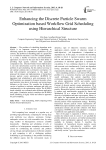
Статья научная
The problem of scheduling dependent tasks (DAG) is an important version of scheduling, to efficiently exploit the computational capabilities of grid systems. The problem of scheduling tasks of a graph onto a set of different machines is an NP Complete problem. As a result, a number of heuristic and meta-heuristic approaches are used over the years due to their ability of providing high quality solutions with reasonable computation time. Discrete Particle Swarm Optimization is one such meta-heuristic used for solving the discrete problem of grid scheduling, but this method converge to sub optimal solutions due to premature convergence. To deal with premature convergence, in this paper we proposed the design and implementation of hierarchical discrete particle swarm optimization (H-DPSO) for dependent task scheduling in grid environment. In H-DPSO particles are arranged in dynamic hierarchy where good particles lying above in hierarchy are having larger influence on the swarm. We consider the bi-objective version of problem to minimize makespan and total cost simultaneously as the optimization criteria. The H-DPSO based scheduler was evaluated under different application task graphs. Simulation analysis manifests that H-DPSO based scheduling is highly viable and effective approach for grid computing.
Бесплатно
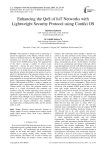
Enhancing the QoS of IoT networks with lightweight security protocol using Contiki OS
Статья научная
The Internet of Things (IoT) is advancing to prevail the application of the Internet, with the vision to connect everything around us. The deployment of IoT is advancing at a very fast pace, and relying on modified versions of the TCP/IP protocol suits. This rapid growth of the field is leaving a number of critical issues unresolved. Among the most critical issues are the quality of service and security of the delivered data. This research is set to tackle these issues through proposing a data delivery scheme that improves the quality of service (QoS) of classified data. The proposed solution relies on differentiating the priority of the delivered data, and to give preferences to secured and user-defined high priority traffic. The proposed solution denoted as Secured Traffic Priority Differentiation (STPD), is made to support any application, and is implemented at the Medium Access Control (MAC) sub layer. The proposed solution was tested in a virtual environment that simulates real scenarios using the Contiki operating system, using the Cooja simulator. The simulation results demonstrated a significant improvement of the proposed solution over the Carrier Sense Multiple Access Collision Avoidance, (CSMA/CA), by at 20%. The proposed solution worked to improve the channel utilization, data reliability, decreased latency of high priority traffic, and low priority traffic as well.
Бесплатно
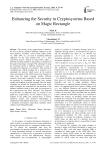
Enhancing the Security in Cryptosystems Based on Magic Rectangle
Статья научная
The security of any cryptosystems is based on the way in which it produces different ciphertext for the same plaintext. Normally, various block cipher modes viz., CBC, OFC, etc., are used in producing different ciphertext for the same plaintext but it is a time consuming process. Instead of using block cipher, a different encoding method for the plaintext is proposed in this paper using magic rectangle. The advantage of using the encoding scheme is different numerals is used in encoding each characters of a plaintext. Thus instead of considering the ASCII encoding for a character to be encrypted, the numeral which occurs at the position which corresponds to the ASCII value of the character is taken from the magic rectangle. Further, different numerals from magic rectangles for the same character are produced by considering the magic sum, starting number and template of magic rectangle. Once the magic rectangles are created, the numerals which occur in the magic rectangles are considered for the encoding of the plaintext character which is then used for encryption in the cryptosystems like RSA, ElGamal. The proposed work provides an additional layer of security to any public key cryptosystems. As this model is acting as a wrapper to any public key cryptosystems, it ensures enhanced security. The proposed methodology is implemented with different processors 1, 2, 4, 8 and 16 in a simulated environment using Maui scheduler which employs back filling philosophy.
Бесплатно
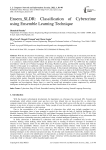
Ensem_SLDR: Classification of Cybercrime using Ensemble Learning Technique
Статья научная
With the advancement of technology, cybercrimes are surging at an alarming rate as miscreants pour into the world's modern reliance on the virtual platform. Due to the accumulation of an enormous quantity of cybercrime data, there is huge potential to analyze and segregate the data with the help of Machine Learning. The focus of this research is to construct a model, Ensem_SLDR which can predict the relevant sections of IT Act 2000 from the compliant text/subjects with the aid of Natural Language Processing, Machine Learning, and Ensemble Learning methods. The objective of this paper is to implement a robust technique to categorize cybercrime into two sections, 66 and 67 of IT Act 2000 with high precision using ensemble learning technique. In the proposed methodology, Bag of Words approach is applied for performing feature engineering where these features are given as input to the hybrid model Ensem_SLDR. The proposed model is implemented with the help of model stacking, comprising Support Vector Machine (SVM), Logistic Regression, Decision Tree, and Random Forest and gave better performance by having 96.55 % accuracy, which is higher and reliable than the past models implemented using a single learning algorithm and some of the existing hybrid models. Ensemble learning techniques enhance model performance and robustness. This research is beneficial for cyber-crime cells in India, which have a repository of detailed information on cybercrime including complaints and investigations. Hence, there is a need for model and automation systems empowered by artificial intelligence technologies for the analysis of cybercrime and their classification of its sections.
Бесплатно
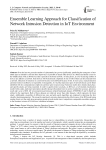
Ensemble Learning Approach for Classification of Network Intrusion Detection in IoT Environment
Статья научная
Over the last two years,the number of cyberattacks has grown significantly, paralleling the emergence of new attack types as intruder’s skill sets have improved. It is possible to attack other devices on a botnet and launch a man-in-the-middle attack with an IOT device that is present in the home network. As time passes, an ever-increasing number of devices are added to a network. Such devices will be destroyed completely if one or both of them are disconnected from a network. Detection of intrusions in a network becomes more difficult because of this. In most cases, manual detection and intervention is ineffective or impossible. Consequently, it's vital that numerous types of network threats can be better identified with less computational complexity and time spent on processing. Numerous studies have already taken place, and specific attacks are being examined. In order to quickly detect an attack, an IDS uses a well-trained classification model. In this study, multi-layer perceptron classifier along with random forest is used to examine the accuracy, precision, recall and f-score of IDS. IoT environment-based intrusion related benchmark datasets UNSWNB-15 and N_BaIoT are utilized in the experiment. Both of these datasets are relatively newer than other datasets, which represents the latest attack. Additionally, ensembles of different tree sizes and grid search algorithms are employed to determine the best classifier learning parameters. The research experiment's outcomes demonstrate the effectiveness of the IDS model using random forest over the multi-layer perceptron neural network model since it outperforms comparable ensembles analyzed in the literature in terms of K-fold cross validation techniques.
Бесплатно

Ensemble feature selection and classification of internet traffic using XGBoost classifier
Статья научная
Identification and classification of internet traffic is most important in network management to ensure Quality of Service (QoS). However, existing machine learning models tend to produce unsatisfactory results when applied with imbalanced datasets involving multiple classes. There are two reasons for this: the models have a bias towards classes which have more samples and they also tend to predict only the majority class data as features of the minority class are often treated as noise and therefore ignored. Thus, there is a high probability of misclassification of the minority class compared with the majority class. Therefore, in this paper, we are proposing an ensemble feature selection based on the tree approach and ensemble classification model using XGboost to enhance the performance of classification. The proposed model achieves better classification accuracy compared to other tree based classifiers.
Бесплатно
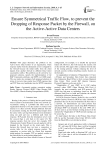
Статья научная
This paper illustrates the problem in the Active-Active Data Centers of an organization, where response traffic from the destination server is dropped by the firewall because the initial traffic from the client departs from another firewall in different Data Center (asymmetric traffic). This problem can be solved by two proposed solutions, namely the implementation of the BGP Community attributes and OSPF over GRE tunnel. The case study also compares both proposed solutions in terms of recovery time, packet loss, ICMP response time and TCP three-way handshake time for HTTP connection.
Бесплатно
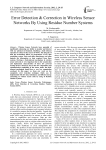
Error Detection & Correction in Wireless Sensor Networks By Using Residue Number Systems
Статья научная
Wireless Sensor Networks have potential of significantly enhancing our ability to monitor and interact with our physical environment. Realizing a fault tolerant operation is critical to the success of WSNs. The integrity of data has tremendous effects on performance of any data acquisition system. Noise and other disturbances can often degrade the information or data acquired from these systems. Devising a fault-tolerant mechanism in wireless sensor networks is very important due to the construction and deployment characteristics of these low powered sensing devices. Moreover, due to the low computation and communication capabilities of the sensor nodes, the fault-tolerant mechanism should have a very low computation overhead. In this paper we focus our work on low complexity error detection technique which can be implemented with low data redundancy and efficient energy consuming in wireless sensor node by using of Residue Number Systems.
Бесплатно

